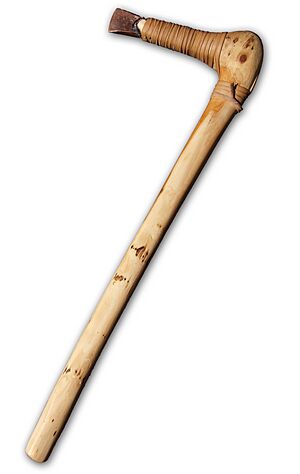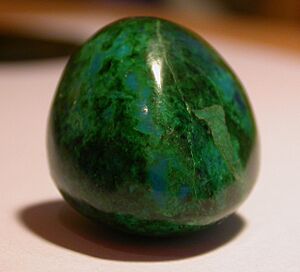Metallurgy during the Copper Age in Europe facts for kids

The Copper Age is also known as the Eneolithic or Chalcolithic Age. It was a time between the Stone Age (when people mostly used stone tools) and the Bronze Age (when they used bronze). During the Copper Age, people slowly started using a new material: metal, especially native copper. Even though they began using copper, stone tools were still very important.
Recent discoveries show that copper didn't just appear slowly. Its arrival brought big changes! Villages became larger, and people started building walls to protect them. There was also more trade over long distances, and new ways of working with copper metal began.
Some of the oldest copper items were found in places like Majdanpek, Jarmovac, and Pločnik in Serbia. These sites belong to the Vinča culture and date back to 5500 BCE. A copper axe from this time was found there! Later, around 5000 BCE, people were working with metal at mines like Rudna Glava in Serbia and Ai Bunar in Bulgaria.
By 3000 BCE, copper items were being made in places like Palmela in Portugal, Cortes in Navarre, and even at Stonehenge in England. It's tricky to set exact dates for the Copper Age because it started at different times in different places.
Contents
How Metalworking Began in Europe
For a long time, people thought that the idea of working with metal came to Europe from the Near East. But now, most experts believe that metalworking started in many different places across Europe, all at different times.
One reason for this idea is that while the final copper objects (like beads, rings, or axes) looked similar, the ways people made them were different. For example, in southern Spain, people used special pots called crucibles to melt copper. In central Europe, they used a different method that created a waste material called slag. In other places, like the British Isles, archaeologists haven't found any waste, which means they used yet another method!
This shows that people in different regions learned to work with copper in their own ways. Some areas, like the Balkans, really embraced copper. But others, like the Basque Country in northern Spain, used copper much less, even though they built amazing large stone structures called dolmens.
Why People Started Using Copper
Copper is a common metal found all over the world. It's one of the few metals that can be found in a pure state, meaning it's not mixed with other materials. This makes it quite easy to work with. You could even hammer a piece of pure copper into a bead!
The shiny look of pure copper probably caught people's eyes. It would have looked even more amazing when turned into jewelry. This might have been a big reason why humans started to experiment with metal.
Getting and Shaping Copper
First, people had to find the raw copper. Copper can be found in over 160 different minerals. To get a lot of copper, people had to start mining. Some common copper minerals they dug up were malachite (which is green) and azurite (which is blue). For example, malachite was mined at Rudna Glava in Serbia and Chinflón in Spain.
You might have heard of Ötzi the Iceman, an ancient mummy found in the Alps. He lived around 3300 BCE. One idea about why he was so high up in the mountains (over 10,000 feet!) is that he might have been looking for new copper minerals.
Once they had the mineral, they needed to separate the copper from the unwanted rock, called gangue. This was done by smelting, which means heating the mineral in a furnace. The furnace had to get super hot, at least 1089°C (1992°F)!
Finally, to work with the copper, people needed special tools. These included furnaces, molds to shape the melted metal, and crucibles (the pots for melting).
Here's how metalworking likely developed in stages:
- Stage A: In very early times, pure copper was easier to find. People could just pick it up from the ground, like in Cyprus or Crete. They shaped this pure copper by cold-hammering it. This was simple, but it only worked for small items like pins or beads. If they tried to make larger objects, the metal would crack.
- Stage B: People learned that heating the copper over an open fire (to about 200-300°C or 392-572°F) made it softer. This process is called annealing. It made the copper much easier to shape without cracking. This allowed them to make slightly bigger items, like bracelets.
- Stage C: As pure copper became harder to find, people started using copper ore (rock mixed with copper). This was a huge step! To get copper from ore, they had to smelt it, which needed special technology. This was the true beginning of metallurgy.
Early Mining in Europe
People knew about copper minerals long before they started making tools from copper. For example, in Crete, tiny pieces of green malachite and blue azurite were ground into powder and used as makeup or to decorate pottery as early as 6000 BCE.
So, at first, people didn't collect these minerals for copper. They liked their bright colors and shine. But this early knowledge was very important. It taught them how to recognize these minerals and where to find them. Later, when they wanted copper, they knew where to look.
Many ancient copper mines have been found across Europe. Some are in the east, like Rudna Glava in Serbia and Ai Bunar in Bulgaria. Others are in the west, like Mount Gabriel in Ireland and Great Orme in the United Kingdom. There are also mines in Central Europe, like Mitterberg in Austria, and in the south, like Riotinto in Spain.
It's interesting that these weren't just single mines. Often, they were large mining complexes with many mine shafts. For example, Rudna Glava had 30 shafts, and Mount Gabriel had 31!
Mining Techniques and Tools
The ways people mined copper were quite similar across Europe. They often used a technique called "fire-setting." This involved building a big fire against the rock face. Once the rock was super hot, they would pour water over it. The sudden change in temperature would cause the rock to crack. Then, they could break the rock completely using stone hammers and picks. After that, they would choose the useful pieces of ore, crush them, and take them to a place where the copper could be processed.
These ancient miners were very smart and efficient with the technology they had. They collected all the useful mineral. When a mine shaft was no longer needed, they carefully filled it back up with waste rock. For example, at Mount Gabriel, it's estimated that miners removed over 32,500 tonnes of rock and ore! From that, they got about 146 tonnes of pure copper.
An old description from 1744 explains their method:
Their method seems to be this. They make a great fire of wood in the bottom of their rakes which were always open up on that account, and when the rock was sufficiently hot they cast water upon it, which shiver’d it; and then with stone wedges, which they drove in with other stones, they work’d their way through the hardest rocks, tho’ but slowly.
Archaeologists have found many tools used by these miners:
- Stone tools: The most common finds are stone hammers. These were usually made from hard rocks found near the mine, or from river pebbles. Many of these hammers had a groove carved around the middle. This groove was for tying a rope, which would attach the hammer to a handle.
- Antler and bone tools: Miners also used picks and scrapers made from animal bones and antlers.
- Wood: Wooden tools are harder to find because wood decays. But shovels and wedges made of wood have been found at places like Ai Bunar and Mount Gabriel. It's also likely they used simple wooden stairs or scaffolding to get around the mines.
- Metal: It's rare to find metal tools used by the miners themselves. It seems they didn't use copper for their own mining tools. However, sometimes copper chisels or broken axes might have been used as wedges.
- Other evidence: Miners needed coal and charcoal for their fires and furnaces. They also used leather sacks and baskets to carry the crushed minerals out of the mines.
Society in the Copper Age
We don't know a huge amount about the daily lives of people in the Copper Age, but we do know some things. Many experts believe that the arrival of metal didn't suddenly change everyone's life. In the early Copper Age, copper was mainly used for jewellery and weapons. These items were probably not available to everyone, but mostly to important or powerful people. This means that copper's main importance was not just for making useful tools, but for showing off social status.
This idea helps explain why "Great Cultures of Metal" appeared. These were groups like the Vinča culture in Eastern Europe, the Unetice culture in Central Europe, and Los Millares in Spain.
As the Copper Age continued, especially around 3000 BCE, new and complex things started to appear. We see impressive fortified villages, like Los Millares in Spain and Vila Nova de Sao Pedro in Portugal. These might have been built to control the areas where copper was mined. We also see widespread cultural trends like Megalithism (building huge stone monuments), Rock Art, and the use of special Bell Beakers (distinctive pottery). These cultural ideas spread across vast areas, from Scandinavia to Spain and from Scotland to Turkey!
See also
- Copper
- Copper Age
- Copper metallurgy in Africa
- Metallurgy
- Native copper



